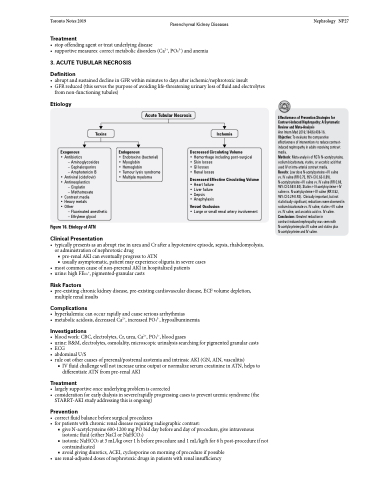Page 727 - TNFlipTest
P. 727
Toronto Notes 2019 Parenchymal Kidney Diseases
Treatment
• stopoffendingagentortreatunderlyingdisease
• supportivemeasures:correctmetabolicdisorders(Ca2+,PO43-)andanemia
3 . ACUTE TUBULAR NECROSIS
Definition
• abruptandsustaineddeclineinGFRwithinminutestodaysafterischemic/nephrotoxicinsult
• GFRreduced(thisservesthepurposeofavoidinglife-threateningurinarylossoffluidandelectrolytes
Nephrology NP27
from non-functioning tubules)
Etiology
Toxins Exogenous
• Antibiotics
– Aminoglycosides – Cephalosporins – Amphotericin B
• Antiviral (cidofovir) • Antineoplastics
– Cisplatin
– Methotrexate • Contrast media
• Heavy metals • Other
– Fluorinated anesthetic – Ethylene glycol
Figure 16. Etiology of ATN
Clinical Presentation
Acute Tubular Necrosis
Effectiveness of Prevention Strategies for Contrast-Induced Nephropathy: A Systematic Review and Meta-Analysis
Ann Intern Med 2016;164(6):406-16.
Objective: To evaluate the comparative effectiveness of interventions to reduce contrast- induced nephropathy in adults receiving contrast media.
Methods: Meta-analysis of RCTs N-acetylcysteine, sodium bicarbonate, statins, or ascorbic acid that used IV or intra-arterial contrast media.
Results: Low dose N-acetylcysteine+IV saline
vs. IV saline (RR 0.75, 95% CI 0.63-0.89). N-acetylcysteine+IV saline vs. IV saline (RR 0.69, 95% CI 0.58-0.84). Statins+N-acetylcysteine+IV saline vs. N-acetylcysteine+IV saline (RR 0.52, 95% CI 0.29-0.93). Clinically important, but not statistically significant, reductions were observed in sodium bicarbonate vs. IV saline, statins+IV saline vs. IV saline, and ascorbic acid vs. IV saline. Conclusions: Greatest reduction in contrast-induced nephropathy was seen with N-acetylcysteine plus IV saline and statins plus N-acetylcysteine and IV saline.
Endogenous
• Endotoxins (bacterial) • Myoglobin
• Hemoglobin
• Tumour lysis syndrome • Multiple myeloma
Ischemia
Decreased Circulating Volume
• Hemorrhage including post-surgical • Skin losses
• GI losses
• Renal losses
Decreased Effective Circulating Volume
• Heart failure • Liver failure • Sepsis
• Anaphylaxis
Vessel Occlusion
• Large or small renal artery involvement
• typicallypresentsasanabruptriseinureaandCrafterahypotensiveepisode,sepsis,rhabdomyolysis, or administration of nephrotoxic drug
■ pre-renal AKI can eventually progress to ATN
■ usually asymptomatic, patient may experience oliguria in severe cases
• mostcommoncauseofnon-prerenalAKIinhospitalizedpatients
• urine:highFENa+,pigmented-granularcasts
Risk Factors
• pre-existingchronickidneydisease,pre-existingcardiovasculardisease,ECFvolumedepletion, multiple renal insults
Complications
• hyperkalemia:canoccurrapidlyandcauseseriousarrhythmias
• metabolicacidosis,decreasedCa2+,increasedPO43-,hypoalbuminemia
Investigations
• bloodwork:CBC,electrolytes,Cr,urea,Ca2+,PO43-,bloodgases
• urine:R&M,electrolytes,osmolality,microscopicurinalysissearchingforpigmentedgranularcasts • ECG
• abdominalU/S
• ruleoutothercausesofprerenal/postrenalazotemiaandintrinsicAKI(GN,AIN,vasculitis)
■ IV fluid challenge will not increase urine output or normalize serum creatinine in ATN, helps to differentiate ATN from pre-renal AKI
Treatment
• largelysupportiveonceunderlyingproblemiscorrected
• considerationforearlydialysisinsevere/rapidlyprogressingcasestopreventuremicsyndrome(the
STARRT-AKI study addressing this is ongoing)
Prevention
• correctfluidbalancebeforesurgicalprocedures
• forpatientswithchronicrenaldiseaserequiringradiographiccontrast:
■ give N-acetylcysteine 600-1200 mg PO bid day before and day of procedure, give intravenous isotonic fluid (either NaCl or NaHCO3)
■ isotonic NaHCO3 at 3 mL/kg over 1 h before procedure and 1 mL/kg/h for 6 h post-procedure if not contraindicated
■ avoid giving diuretics, ACEI, cyclosporine on morning of procedure if possible • userenal-adjusteddosesofnephrotoxicdrugsinpatientswithrenalinsufficiency


